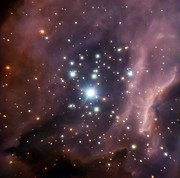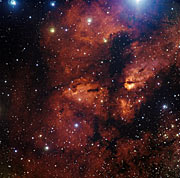Lehdistötiedote
Näkymä aurinkojen ja aurinkokuntien tuliseen alkukotiin
19. elokuuta 2009
ESOn tänään julkaisemat uudet kuvat avaavat näkymän RCW 38:ksi kutsutun kosmisen pilven sydämeen, joka on täynnä aluillaan olevia tähtiä ja aurinkokuntia. Valtavat nuoret tähdet pommittavat aluillaan olevia aurinkoja ja planeettoja voimakkailla tuulilla ja häikäisevällä valolla. Niiden tuhoisaa työtä edesauttavat lyhytikäiset massiiviset tähdet, jotka räjähtävät supernovina. Joskus energiavyöry tuhoaa materian, josta ajan kuluessa saattaisi muodostua uusia aurinkokuntia. Tiedemiehet uskovat, että oma aurinkokuntamme sai alkunsa samanlaisessa dramaattisessa ympäristössä.
RCW 38 on tiheä tähtijoukko, joka hohtaa noin 5500 valovuoden päässä, Vela-tähdistön (Purjeen tähdistön) suunnassa. Orionin kaasusumun tähtijoukon, tavoin RCW 38 on "uppoutunut tähtijoukko", jonka tähtiä syntymävaiheen pöly ja kaasupilvi yhä ympäröi. Tähtitieteilijät ovat päätelleet, että suurin osa tähdistä syntyy näissä tiheäaineisissa olosuhteissa, mukaan lukien pienimassaiset punertavat tähdet, joita maailmankaikkeudessa on eniten. Uppoutuneet tähtijoukot tarjoavat tutkijoille elävän laboratorion, jossa voidaan tutkia tähtien ja planeettojen syntymekanismeja.
“ Tarkastelemalla RCW 38:n kaltaisia tähtijoukkoja voimme oppia paitsi oman aurinkokuntamme ja muiden aurinkokuntien alkuperästä, myös tulevien tähtien ja planeettojen synnystä”, toteaa Kim DeRose, Astronomical Journalissa julkaistavan uuden tutkimuksen pääkirjoittaja. DeRose tutki RCW 38:aa opiskellessaan Harvard-Smithsonian Center for Astrophysics -keskuksessa Yhdysvalloissa.
Tähtitutkijat saivat tähän mennessä terävimmän kuvan RCW 38:sta käyttämällä ESOn VLT-teleskoopin (Very Large Telescope) adaptiivisen optiikan tutkimusvälinettä NACOa [1], He tarkensivat massiivista IRS2-tähteä ympäröivän tähtijoukon keskiosaan, joka hohtaa polttavan kirkkaana sininen–valkoinen-spektriluokassa. Tämä on kuumin mahdollinen tähtien pinnan väri ja lämpötila. Yllättävät havainnot paljastivat, että IRS2 ei olekaan yksi tähti, vaan se koostuu kahdesta tähdestä. Hehkuvien kaksoistähtien välinen etäisyys on noin 500 AU:ta (AU = maan ja auringon välimatka).
Tähtitieteilijät löysivät NACO-kuvasta joukon prototähtiä, jotka ovat varsinaisten tähtien himmeitä esiasteita. Kuvasta löytyi myös tusinoittain muita tähtialkioita, jotka ovat sinnitelleet tällä alueella IRS2:n voimakkaasta ultraviolettisäteilystä huolimatta. Osa näistä tähdistä ei luultavasti kuitenkaan pääse prototähtivaihetta pidemmälle. IRS2:n voimakas säteily energisoi ja hajottaa ainetta, josta muuten saattaisi muodostua uusia tähtiä tai josta on muodostunut ns. protoplanetaarisia kiekkoja kehittyvien tähtien ympärille. Miljoonien vuosien kuluessa jäljellejääneet kiekot saattavat muodostaa planeettoja, kuita ja komeettoja, joista syntyy oman aurinkokuntamme kaltaisia aurinkokuntia.
Vahvojen ultraviolettisäteiden lisäksi RCW 38:n kaltaiset synnyinsijat altistavat muodostamansa tähdet usein esiintyville supernoville, kun jättiläistähdet räjähtävät elinaikansa loputtua. Nämä räjähdykset levittävät lähiavaruuteen monenlaisia aineksia, esimerkiksi harvinaisia isotooppeja – kemiallisten alkuaineiden epätavallisia olomuotoja, jotka syntyvät kuolevissa tähdissä. Pois lentänyt aine päätyy lähistöllä muodostuviin seuraavan sukupolven tähtiin. Koska samoja isotooppeja on havaittu omassa auringossamme, tutkijat ovat päätelleet, että Aurinko on muodostunut RCW 38:n kaltaisessa tähtijoukossa, sen sijaan että se olisi muodostunut rauhallisemmassa osassa Linnunrataa.
“Adaptiivisen optiikan paljastamat yksityiskohdat tähtitieteellisissä kohteissa ovat keskeisiä tietoja, joiden perusteella voimme päätellä, miten uudet tähdet ja planeetat syntyvät RCW 38:n kaltaisilla monimutkaisilla ja kaoottisilla alueilla”, toteaa Dieter Nürnberger, yksi tutkimuksen tekijöistä.
Lisähuomiot
[1] NACO-nimitys on muodostettu yhdistämällä Nasmyth Adaptive Optics System (NAOS) ja Near-Infrared Imager and Spectrograph (CONICA). Adaptiivinen optiikka kompensoi suurimman osan kuvaa vääristävästä Maan ilmakehän turbulenssista, joka johtuu lämpötilan vaihtelusta ja tuulista.
Lisätietoa
Tämä tutkimus on julkaistu Astronomical Journal -julkaisussa: A Very Large Telescope / NACO study of star formation in the massive embedded cluster RCW 38, DeRose et al. (2009, AJ, 138, 33–45).
Tutkijaryhmän jäsenet ovat: K.L. DeRose, T.L. Bourke, R.A. Gutermuth ja S.J. Wolk (Harvard-Smithsonian Center for Astrophysics, Cambridge, USA), S.T. Megeath (Department of Physics and Astronomy, The University of Toledo, USA), J. Alves (Centro Astronómico Hispano Alemán, Almeria, Spain) ja D. Nürnberger (ESO).
ESO (European Southern Observatory, Euroopan eteläinen observatorio) on tähtitieteen keskeinen eurooppalainen hallitustenvälinen organisaatio. Se on maailman tuottoisin tähtitieteellinen observatorio. Sen toimintaa tukee 14 maata: Alankomaat, Belgia, Espanja, Iso-Britannia, Italia, Itävalta, Portugali, Ranska, Ruotsi, Saksa, Suomi, Sveitsi, Tanska ja Tšekin tasavalta. ESO toteuttaa kunnianhimoista ohjelmaa, joka keskittyy tehokkaiden maanpäällisten tutkimusvälineiden kehittämiseen, rakentamiseen ja toimintaan. Tähtitieteilijöiden käytössä olevat tutkimusvälineet mahdollistavat tärkeiden tieteellisten havaintojen tekemisen. ESO on myös johtavassa asemassa tähtitieteen tutkimuksen edistämisessä ja yhteistyön järjestämisessä. ESOlla on Chilessä kolme huippuluokan observatoriota: La Silla, Paranal ja Chajnantor. ESOlla on Paranalissa VLT-teleskooppi. Se on maailman edistynein näkyvän valon aallonpituuksia havainnoiva tähtitieteellinen observatorio. ESO on maailman suurimman tähtitieteen alan projektin, täysin uudenlaisen ALMA-teleskoopin, eurooppalainen yhteistyökumppani. ESO suunnittelee 42-metristä E-ELT-teleskooppia (European Extremely Large optical/near-infrared Telescope, Euroopan erittäin suuri optinen/lähi-infrapuna-alueen teleskooppi), josta tulee maailman suurin taivasta tarkkaileva silmä.
Linkit
- Tieteellinen julkaisu: http://arxiv.org/abs/0904.3279 tai http://www.iop.org/EJ/abstract/1538-3881/138/1/33/
- Adaptiivinen optiikka -sivu
- VLT-sivu
Yhteystiedot
Dieter Nürnberger
ESO
Chile
Puh.: +56 2 463 3080
Sähköposti: dnuernbe@eso.org
Pasi Nurmi (Lehdistön yhteyshenkilö Suomi)
ESO Science Outreach Network
ja University of Turku
Turku, Finland
Puh.: +358 29 4504 358
Sähköposti: eson-finland@eso.org
Tiedotteesta
| Tiedote nr.: | eso0929fi |
| Legacy ID: | PR 29/09 |
| Nimi: | RCW 38 |
| Tyyppi: | Milky Way : Star : Grouping : Cluster |
| Facility: | Very Large Telescope |
| Instruments: | NACO |
| Science data: | 2009AJ....138...33D |
Our use of Cookies
We use cookies that are essential for accessing our websites and using our services. We also use cookies to analyse, measure and improve our websites’ performance, to enable content sharing via social media and to display media content hosted on third-party platforms.
ESO Cookies Policy
The European Organisation for Astronomical Research in the Southern Hemisphere (ESO) is the pre-eminent intergovernmental science and technology organisation in astronomy. It carries out an ambitious programme focused on the design, construction and operation of powerful ground-based observing facilities for astronomy.
This Cookies Policy is intended to provide clarity by outlining the cookies used on the ESO public websites, their functions, the options you have for controlling them, and the ways you can contact us for additional details.
What are cookies?
Cookies are small pieces of data stored on your device by websites you visit. They serve various purposes, such as remembering login credentials and preferences and enhance your browsing experience.
Categories of cookies we use
Essential cookies (always active): These cookies are strictly necessary for the proper functioning of our website. Without these cookies, the website cannot operate correctly, and certain services, such as logging in or accessing secure areas, may not be available; because they are essential for the website’s operation, they cannot be disabled.
Functional Cookies: These cookies enhance your browsing experience by enabling additional features and personalization, such as remembering your preferences and settings. While not strictly necessary for the website to function, they improve usability and convenience; these cookies are only placed if you provide your consent.
Analytics cookies: These cookies collect information about how visitors interact with our website, such as which pages are visited most often and how users navigate the site. This data helps us improve website performance, optimize content, and enhance the user experience; these cookies are only placed if you provide your consent. We use the following analytics cookies.
Matomo Cookies:
This website uses Matomo (formerly Piwik), an open source software which enables the statistical analysis of website visits. Matomo uses cookies (text files) which are saved on your computer and which allow us to analyze how you use our website. The website user information generated by the cookies will only be saved on the servers of our IT Department. We use this information to analyze www.eso.org visits and to prepare reports on website activities. These data will not be disclosed to third parties.
On behalf of ESO, Matomo will use this information for the purpose of evaluating your use of the website, compiling reports on website activity and providing other services relating to website activity and internet usage.
Matomo cookies settings:
Additional Third-party cookies on ESO websites: some of our pages display content from external providers, e.g. YouTube.
Such third-party services are outside of ESO control and may, at any time, change their terms of service, use of cookies, etc.
YouTube: Some videos on the ESO website are embedded from ESO’s official YouTube channel. We have enabled YouTube’s privacy-enhanced mode, meaning that no cookies are set unless the user actively clicks on the video to play it. Additionally, in this mode, YouTube does not store any personally identifiable cookie data for embedded video playbacks. For more details, please refer to YouTube’s embedding videos information page.
Cookies can also be classified based on the following elements.
Regarding the domain, there are:
- First-party cookies, set by the website you are currently visiting. They are stored by the same domain that you are browsing and are used to enhance your experience on that site;
- Third-party cookies, set by a domain other than the one you are currently visiting.
As for their duration, cookies can be:
- Browser-session cookies, which are deleted when the user closes the browser;
- Stored cookies, which stay on the user's device for a predetermined period of time.
How to manage cookies
Cookie settings: You can modify your cookie choices for the ESO webpages at any time by clicking on the link Cookie settings at the bottom of any page.
In your browser: If you wish to delete cookies or instruct your browser to delete or block cookies by default, please visit the help pages of your browser:
Please be aware that if you delete or decline cookies, certain functionalities of our website may be not be available and your browsing experience may be affected.
You can set most browsers to prevent any cookies being placed on your device, but you may then have to manually adjust some preferences every time you visit a site/page. And some services and functionalities may not work properly at all (e.g. profile logging-in, shop check out).
Updates to the ESO Cookies Policy
The ESO Cookies Policy may be subject to future updates, which will be made available on this page.
Additional information
For any queries related to cookies, please contact: pdprATesoDOTorg.
As ESO public webpages are managed by our Department of Communication, your questions will be dealt with the support of the said Department.





